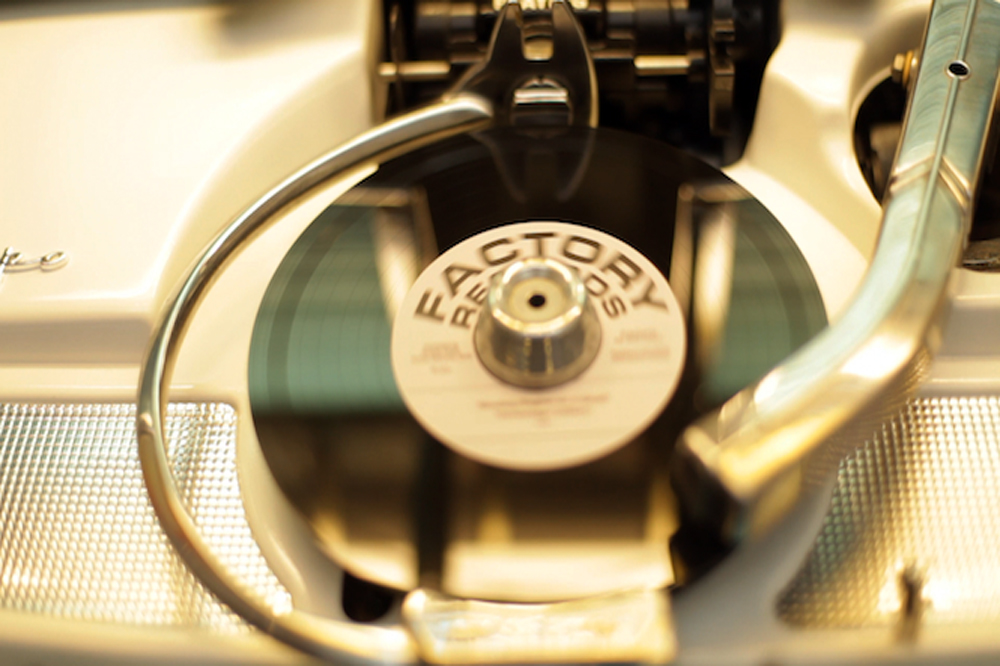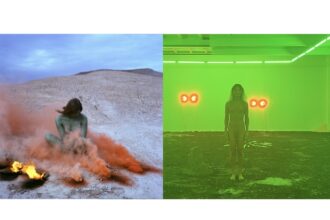Consuming visual art is conspicuously, if oddly, social. You are inherently distracted, aware of watching and being watched, even, perhaps especially, in the darkened spaces of video installations in which the comings and goings of strangers are a given. The very word “gallery” suggests, architecturally, a widened corridor in which you are meant to linger but not stay. It’s an exhausting form of browsing (over two-dozen shopping malls across the world are now called “Galleria”) and of eating, buffet-style. Digestion is rarely included in the process.
The Venice Biennale dates to the late-19th century and has changed through the decades, but not much. It’s no longer directly tied to the art market (it used to have a sales desk), though it retains many obvious, indirect connections. This, despite the event’s recent curators, notable among them Francesco Bonami in 2003, trying to rearrange, or at least startle, the template. This, despite various protests and unsanctioned projects, such as those of 1968, trying to explode the event’s hegemony. Like the modernist art institution, the Venice Biennale persists in the capitalist mode, absorbing rather than adapting to structural critique.
So it was that this year’s politically leftist Biennale, artistic-directed by Nigerian power curator Okwui Enwezor, felt ineffectual. Could it have been otherwise? On preview week, we peered at Enwezor’s radicalism as if from an observation deck, muttering “dark” and “political” while carrying on, business-as-usual, gawking and texting. It didn’t matter that many of us had, say, read Debord. In press conferences and interviews, Enwezor sincerely discussed his intentions while at the same time conceding to the systemic limitations of making a Venice Biennale exhibition truly radical.
In one such piece, with Artforum’s Michelle Kuo, Enwezor spoke of his interest in the Biennale as a “space of residue,” responding to Kuo’s subsequent question about the “risk of simply flattening” this idea through the context of the Biennale’s own, prestigious group show: “I see no way of such flattening happening,” he said. “This will not be like roaming the streets of Chelsea or the corridors of art fairs … My motto for the moment is access and accessibility.” What? The Biennale is not an accessible event. Venice is expensive to get to and expensive to stay in; it is difficult to navigate. Regular full-price tickets to the Biennale are 25 euros.
Yet Enwezor insists on Marx in All The World’s Futures. The exhibition’s “core part” is Das Kapital Oratorio, a live reading of Das Kapital mingled with various performances, on a grand central stage in the main pavilion of the Giardini. To talk about Marx is, naturally, to talk about labor. Enwezor topically acknowledges this through the work of Joachim Schönfeldt, Oscar Murillo, Tetsuya Ishida, and many others. But to talk about Marx and labor in an exhibition context – one of the biggest in the world, and the art-historical model for the contemporary fairs Enwezor summarily denounces – should be to talk about commodity fetishism, Marx’s idea is that capitalism makes us impart a religious aura to goods, turning their market value into their only value, and obscuring the original labor and laborers that went into their production. While contemporary art has produced decent work about this, it has struggled to walk the talk, with so much anti-fetishist curatorial efforts becoming, with disturbing swiftness, new sites of fetishization. For Enwezor, tackling commodity fetishism as an exhibition-maker seems a low, if nonexistent, priority.
It’s worth noting that the Marxism of Walter Benjamin, whom Enwezor uses as a pivot point for his exhibition statement, was informed by Brecht, whose own response to the problem of commodity fetishism, and indeed labor, was of course to alienate audiences, preventing them from psychologically identifying with characters and from suspending disbelief. To this end, Enwezor’s exhibition uses three “filters”: “Garden of Disorder,” “Liveness: On Epic Duration” and “Reading Capital,” with the Biennale itself “as a filter through which to reflect on both the current state of things and the appearance of things.” It’s all quite vague. “Disorder” seems key, with “a diversity of practices” left for the viewer to sift and sort. This is inspired, Enwezor claims, by “Sergei Eisenstein’s idea of a dialectical montage” – of editing in film form as expressing disjuncture as well as an unsettling type of unity.
In the Arsenale portion of All the World’s Futures, none of this is apparent. Eisenstein’s montage was directed and purposeful, not disordered. Enwezor’s own montage is a euphemism for serial curating: few works share the same space, and the ones that do are either neatly juxtaposed or politely cordoned. As usual with the Biennale, it is over-programed, a pointed impediment if a curator aims to provoke and unsettle. There are no didactic panels, which might be refreshingly disorderly were there not so much ethnocultural, political, and intellectual context to parse. (You may purchase a hefty 80-euros catalogue at the gift shop if you want to know more.)
Nothing at the Arsenale prompts a deeper consideration of the Biennale’s history and current function. Nothing disturbs the received exhibition context of contemporary art. Nothing, for instance, makes us aware that the Arsenale had a history as a rope, munitions, and ship-building factory, a former site of intensive manufacture that is among the earliest examples of the rapid production process that eventually led to the assembly line. Stunning works such as Keith Calhoun and Chandra McCormick’s Slavery, The Prison Industrial Complex, a photographic series documenting lingering 13th-ammendment-sanctioned slavery in US prisons, maintain the Arsenale’s current usage as a place in which to view ideas and events from afar.
Rirkrit Tiravanija’s performance/installation Untitled 2015 (14086 unfired) consists of Chinese brickworkers making bricks stamped with the Situationist slogan “Ne travaillez jamais” in Chinese characters. For 10 euros, you can purchase a brick, with the money going to ISCOS, an Italian NGO that supports international workers’ rights. “The labor of the brick workers in transformed into art,” writes Tim Roerig in the Biennale’s short guide, as if this somehow makes it more valuable.
Tiravanija’s aesthetics have a zoological or anthropological quality. His call for donation is reminiscent of Clarissa Dalloway’s “shilling into the Serpentine” – a small gesture of bourgeois closure. Tiravanija’s workers are not named, just as the Thai artists who executed his Demonstration Drawings in the Giardini are not. Elsewhere in the Arsenale, the Gulf Labor Artist Coalition hangs a giclée banner graphically representing the migrant South Asian workers who are building branches of the Guggenheim, the Louvre, and NYU in Abu Dhabi. When I stood before it, a woman sped by to take a photo of an adjacent Gedi Sibony work. Will the GLAC occupy the Arsenale as they did New York’s Guggenheim on May Day? There is a need for actual, disruptive voices of non-artist laborers in the Arsenale. IM Heung-soon’s video Factory Complex, installed in a small, black-curtained space before Tiravanija’s piece, documents the exploitation of women workers in Korea. It’s a moving account of resistance from the front-lines, and it has little to do with aesthetics.
At the entrance to the Giardini’s main pavilion (likely Enwezor’s specifically-intended “Garden of Disorder,” given its name), Murillo hangs long, black, stitched-together canvases behind the entrance’s columns. In Roerig’s words, he is “subverting the stateliness of the neo-classical façade,” though they look quite ornamental. A beautiful new neon work by Glenn Ligon covers the pavilion’s sign, evocatively reading “blues blood bruise,” words from Harlem-Six teenager Daniel Hamm. Given Enwezor’s overtures to inclusion, it seems relevant that Ligon and Murillo are represented by David Zwirner, and that five other Zwirner artists – Jason Rhoades, Marlene Dumas, Kerry James Marshall, Iza Genzken, and Chris Offili (six if you count Adel Abdessemed, no longer with the gallery) – appear in All the World’s Futures. Enwezor’s inclusiveness is predicated on giving lesser-known artists proximity to power. Make no mistake: this is an artworld Biennale.
The appropriately-named The ARENA is where Enwezor’s ambitions come to roost. It’s a theater designed by architect David Adjaye that takes up a significant portion of the Giardini’s main pavilion, and is home to the aforementioned Oratorio (orchestrated by Isaac Julien) and a variety of related performances. Adjaye’s is a thrust stage, painted an unsubtle red; you can see and sense an audience through dim lights. It’s hard to judge the efficacy of the project, which seemed risibly contradictory when I first read about it. No one will see it all.
My two experiences of The ARENA were uneven. Its performances bled audibly through much of the building, demanding a certain attention. Its central throughway provided an easy means of escape. I was captivated, however, by Jeremy Deller’s Broadsides and Ballads of the Industrial Revolution, for which a young woman with blue hair and a floral dress sang the titular works, giving powerful voice to a vernacular, sentimental art. She was clearly nervous, straying from ballad rhythm often, but increasingly possessed by the words she sang. One ballad was from the perspective of a 13-year-old factory girl, a limning of the changes industrialization, not puberty, had wrought on her body. By the end of the song the blue-haired woman was in tears; I watched through my own. The ballads, presented by Deller as a political readymade, proved that art can emerge from absolute necessity, that song and speech have a durability, even a purity, beyond material.
Deller’s installation elsewhere in the Giardini is similarly concerned with the culture of labor created by laborers themselves, whether wittingly or unwittingly. He is admirably reluctant to speak for laborers or to style their experiences into art. (Indeed, All the World’s Futures seems otherwise ignorant of the 20th-century’s fraught engagement with social realism, with Walker Evans’s Let Us Now Praise Famous Men un-ironically presented around the corner from Deller’s works.) A jukebox plays ambient recordings of factory noises, and Deller calls this Factory Records. In The Shit Old Days, he furnishes a series of Victorian photographs of anonymous women ironworkers from South Wales – stiff, uncomfortable, and wan in their studio-backdrop poses, their faces and bodies articulate with pain and injustice. Contra Enwezor, Deller employs didactics, using them in the manner of acerbic historical plaques. It’s profoundly affecting.
Early during preview week I saw Enwezor leading a group of suited men through the Arsenale, trailed by security personnel and a small flock of paparazzi. It may have been President Sergio Mattarella, or Prime Minister Matteo Renzi; I glimpsed Italian-flag sashes. Enwezor possessed an expert calm, performing exceptionally as an employee of contemporary art. I thought of Kendrick Lamar’s “The Blacker the Berry,” a song about how public, political figures are particularly vulnerable to accusations of hypocrisy, ones Lamar defiantly and devastatingly owns. I also thought, less generously, of Suhail Malik’s ideas on the necessity of exiting rather than escaping contemporary art, for to try to escape it is merely to reinforce and perpetuate its limitations and inequities.
All the World’s Futures becomes most potent in its failures. In this way, Enwezor’s best statement on labor is unknowingly made through the framework of the artworld that sustains him: so many efforts exploited, diverted, misdirected; so much unfounded, inflated, impotent notions of what art can do, and be. So much work behind us, so much work ahead.























